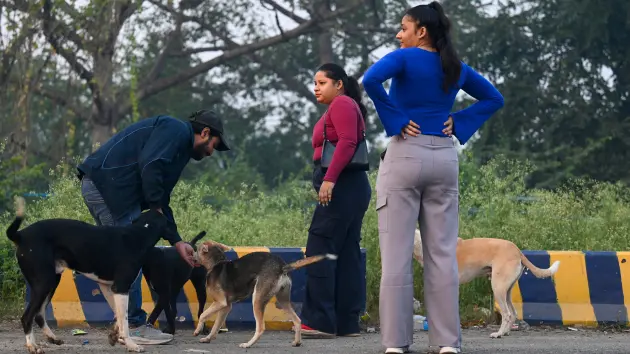(NEW YORK) — The Supreme Court of India issued an order directing all states and union territories to remove stray dogs from public spaces — including schools, universities, hospitals, and transport hubs — sparking a debate about animal welfare.
The move came through a suo motu petition, where the court takes on a matter of public interest without any official petition, and was said to be in response to the alarming number of dog-bite incidents and the threat to human safety, particularly children.
The order called for dogs that are taken off the street for preventative medical treatments — including those related to rabies — to not be returned. They are meant to be shifted to a “designated shelter,” as per the judgement, because India’s 2023 law doesn’t allow culling.
The conditions and capacity of these shelters to host millions of India’s stray dogs has been questioned by activists and protestors.
Although some animal rights groups have noted a need for a solution to the problems caused by the dogs, some have also called the proposed approach into question.
The judgment announced on Nov. 7 cites several media reports and incidents, including one with a Welsh entrepreneur who was bitten by a stray dog during a morning run in Bengaluru, a city in India’s south.
India had an estimated 9 million dogs in their 2019 livestock census; other surveys done in 2021 estimated the number much higher, at 52 million. In 2024, the country recorded 3.7 million dog bite incidents and 54 human deaths from rabies. Estimated cases of rabies have declined by 75% between 2003 and 2023.
“These numbers have been falling steadily for two decades — the court orders do not seem to have taken this official and research data into consideration,” said Dr. Krithika Srinivasan, professor of political ecology at the University of Edinburgh.
Until now, India’s stray dog management was guided by the Animal Birth Control (ABC) Rules, under which stray dogs were to be sterilized, vaccinated and dewormed before being released back into the same locality.
Though the recent judgment calls for the dogs not to be released back at all.
“Stable dog populations are less likely to bite and transmit rabies,” Srinivasan said. “When you start removing them, you create what ecologists call a perturbation effect.”
Ayesha Christina Benn, founder of Neighbourhood Woof and a longtime partner of the local urban body in implementing the ABC program, warned that infrastructure simply cannot handle the court’s directive.
Benn says the order isn’t practical. Delhi alone has a million dogs, and almost 20 centers to house them. “These centers themselves lack compliance,” Benn said. “We had to tear ours down and rebuild it to meet the norms.”
Her NGO currently receives the equivalent of about $11 per dog for sterilisation and vaccination — which is about two-thirds of the actual cost per dog. The government doesn’t have the necessary funds.
A similar directive was issued by the same court, in August, but on a smaller scale in Delhi National Capital Region. This directive was rescinded after protests from animal-rights groups.
In the current judgment, the court wants adequate fencing, boundary walls and gates around education institutes and hospitals within eight weeks.
Akanksha Majumdar, a lawyer by training, said, “The judgment is a step in the right direction, but detached from the ground reality.”
She runs an organization called The Philanthropist and the Happy Dog, which assists in the rescue and rehabilitation of community animals, including dogs and cats. Her group is “taking steps to file a review petition against the said order,” she said.
Srinivasan said she agreed that while the ABC policy’s implementation needs improvement, it has nonetheless been instrumental in bringing down rabies and dog population numbers in some regions.
She attributed the country’s progress to two key factors: the widespread availability of post-exposure prophylaxis for bite victims and the 2001 decision to end mass culling in favour of sterilisation and vaccination programmes.
Yet, despite the long-term decline, controversies around stray dogs have grown. Srinivasan warned that such incidents, while tragic, cannot be effectively addressed by policy decisions that are not based on long-term, nation-wide data and evidence that show which strategies have been successful.
Srinivasan said officials should focus on what has worked: Ensure human anti-rabies treatment is available across the country, avoid regular mass feeding of complete meals to prevent increases in dog population density in particular locations, and, of course, the vaccination-sterilization program.
And, to make them more effective, she said, officials should take the help of grassroots groups that work in the community and understand the dogs better.
Copyright © 2025, ABC Audio. All rights reserved.

